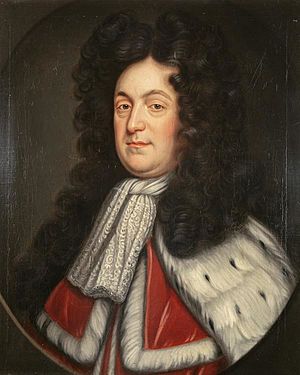John Hamilton, 2nd Lord Belhaven and Stenton facts for kids
Quick facts for kids
John Hamilton
|
|
|---|---|
| Lord Belhaven and Stenton | |

The 2nd Lord Belhaven.
|
|
| Born | 5 July 1656 |
| Died | 21 June 1708 (aged 51) |
| Nationality | Scottish |
| Father | Robert Hamilton, Lord Presmennan |
John Hamilton, 2nd Lord Belhaven and Stenton (born July 5, 1656 – died June 21, 1708) was an important Scottish nobleman, landowner, and politician. He played a big role in Scottish politics during a time of major changes.
Contents
Early Life and Family
John Hamilton was the oldest son of Robert Hamilton, Lord Presmennan. He was born in 1656. He married Margaret, who was the granddaughter of John Hamilton, 1st Lord Belhaven and Stenton. The 1st Lord Belhaven had been given his title by King Charles I in 1647. When the 1st Lord died in 1679, John Hamilton became the 2nd Lord Belhaven and Stenton.
Political Career
John Hamilton was a strong voice in Scottish politics. In 1681, he was put in prison. This happened because he disagreed with the government and spoke against James, Duke of York, who later became King James VII and II.
In 1689, he was one of the people who asked William of Orange to take over the government of Scotland. John Hamilton also fought in the Battle of Killiecrankie in 1689. He was a member of the Privy Council of Scotland, which was a group of important advisors to the monarch in Scotland.
Business and Farming Interests
Lord Belhaven was a director and invested a lot of money in the Company of Scotland. This company was started in 1695. It was responsible for a plan called the Darien scheme. This plan aimed to set up a Scottish colony on the Darien peninsula in Panama. However, the scheme failed and caused many problems for Scotland.
He was also very interested in making farming better. In 1699, he published a helpful book called The Countryman's Rudiments. This book shared ideas on how to improve farming methods.
Opposing the Union
John Hamilton strongly believed that Scotland should have more freedom. He supported the movement that led to the Act of Security in 1705. This law aimed to protect Scotland's independence.
He was very much against the union of the Scottish and English parliaments. This union meant that Scotland and England would become one country, Great Britain. In November 1706, he gave a very famous speech against this idea. He was known as one of the most powerful speakers in politics, along with Andrew Fletcher of Saltoun. Two of his speeches, including the famous one from 1706, were published in a book by Daniel Defoe called History of the Union.
Later Life and Death
Later in his life, John Hamilton was put in prison again. This time, it was because people thought he supported a planned French invasion. He died in London on June 21, 1708.
Successors to the Title
John Hamilton's son, also named John, became the 3rd Lord Belhaven after his father's death. This John fought for the British Government at the Battle of Sheriffmuir. Sadly, he drowned in November 1721 while on his way to become the governor of Barbados. His son, John (who died in 1764), then became the 4th Lord.
After the 4th Lord's brother James died in 1777, the title of Lord Belhaven was not used for a while. Then, in 1799, the House of Lords decided that William Hamilton (1765–1814) was the rightful 7th Lord. He was a descendant of the 2nd Lord's great-grandfather.
William's son, Robert (1793–1868), became the 8th Lord. He was also given a special title as Baron Hamilton of Wishaw in 1831. Robert died in 1868 without any children, so the title of Baron Hamilton ended. In 1875, the House of Lords declared that his cousin, James Hamilton (1822–1893), was the rightful Lord Belhaven and Stenton. The title then passed down to his relative, Alexander Charles (born 1840), who became the 10th Lord.

